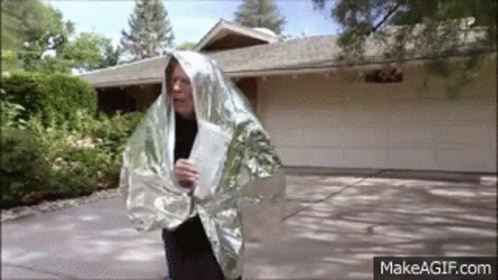The Sapienza computer scientists say Wi-Fi signals offer superior surveillance potential compared to cameras because they’re not affected by light conditions, can penetrate walls and other obstacles, and they’re more privacy-preserving than visual images.
[…] The Rome-based researchers who proposed WhoFi claim their technique makes accurate matches on the public NTU-Fi dataset up to 95.5 percent of the time when the deep neural network uses the transformer encoding architecture.
95.5% accuracy is abysmal for any use case these people want to use it for
Wait… so the guys with tinfoil hats were on to something?
Except that the tinfoil hats don’t work
Maybe wearing a different tinfoil hat every day would mess up a person’s “fingerprint”
The resulting image must just basically look like a shadow, I can’t imagine that they’re going to get much internal detail with Wi-Fi considering that my router’s signal practically gets blocked by a piece of cardboard.
This research essentially amounts to, humans can be individually identified with nothing more than low quality x-rays. Well yeah, so what, you can also use visible light and in any situation where you’re going to use Wi-Fi to detect someone, it’s got to be easier to buy a cheap CCTV camera.
First of all: cardboard does NOT block electromagnetic waves. You need a Faraday Cage for that. And even then, it has to have holes of a certain size to block specific wavelengths/frequencies. It’s why you have a mesh on the door of your microwave for example.
Secondly: they’re not attempting to photograph you. Just identifying your unique signature once would allow them to track your location anywhere where they have the gear installed.
Given your in-depth knowledge of Wi-Fi to consider it blocked by cardboard, I somehow doubt the rest of this comment is credible…
Why would someone research something like this? God damn, like use your life for good, homie
Everything is incremental progress in some way.
I remember years back someone doing experiments with Wi-Fi to see if a room was occupied based on signal attenuation.
This just looks like an extension of that.
Not everything is a giant leap
Well I heard about this and thought “this will be great for home automation”, but I also know that someone was equally excited about using this to rob people of basic freedoms or being a fucking creep or both.
If it’s your home why can’t you just have a camera or motion sensor. Rather than trying to adapt something that isn’t designed for the purpose.
Cameras require light, while radio waves works almost as well in darkness.
A motion sensor is an extra device that needs to be connected, have power and so on.
There are already radio wave motion- and room occupancy sensors where you can specify zones and so on, but if I could have personalized on top of that I’d take it.
Finally, using a thing for something useful other than its intended purpose is kinda fun.
I can imagine this being initially an accidental discovery like oh every time so and so’s body interacts with the WiFi signal it’s the same pattern… until someone starts exploring this further… and then some engineer or their manager started looking for applications for this. In my experience engineering researchers especially are very good with coming up with use cases for whatever tech they’re working with, with little ethical consideration.
I doubt it. You’d need to be looking really closely at the waveforms to notice this, so they were likely already doing something similar, like that research that can pinpoint where people are in a house based on their WiFi. They were probably already doing something creepy before they noticed that this was more straightforward than they expected.
Once you start playing with radiowaves and antenna you start noticing the intricate ways it plays with and around bags of water like bodies. I’m sure the original research on location/movement tracking was due to scientists trying not to get interference, later once they figured it out it was natural to see how much data they could get out of a radio interference profile.
I remember the original tech was going to be marketed as a way to tell if your old person (parent etc) had fallen down and stopped moving. Not the best use case, and then the privacy implications became clear. Once that happens the race begins to exploit the tech.
…But the eventuality here is something like a Star Trek tricorder that can take multiple vitals and detect irregularities from across the waiting room. Sensors that remember who was in a room and what settings they had. Etc. Some cool thing besides the bad stuff (microtarget those ads).
This shits already used by xfinity
I was having a nice day :(
Yes, according to your wifi fingerprint, you had.
https://www.youtube.com/watch?v=aQn9L-wkq_c&t=1m29s
Incorrect bio-signature detected, drink verification can to continue your content.
Legendary reference
Stilsuits: get it for the unbearable heat as we turn the Earth into a desert, now with wifi blocking!
Great, another dystopian way for authorities to observe me on the shitter
Your poo time has expired and your pay is docked. Flushing will cost 50 dollars for the next week. Get back to work
You get poo time? That’s socialism!
All time is poo time when you’re close to the boss’s desk
Please drink a verification laxative?
accurate matches up to 95.5% of the time
and they’re more privacy-preserving than visual images
Oh fuck all the way off.
When anyone or anything says that their product works “up to x%” I always presume it doesn’t really work at all.
Christ, 1% is included in that “up to 95.5%” vague bullshit statement.I believe the reason they had to say “up to” is because the “signatute” will vary day to day ever so slightly (natural weight fluctuation), and if you gain or lose weight it can change dramatically, so the AI would have to constantly consider that and adjust it’s records.
Honestly, unpopular opinion, but as long as it isn’t very short wavelength RF and they allow for self-hosted/open-source alternatives, I do find it a bit more privacy respecting than cameras, of course they have to say they are using the technology in public places.
It also has it’s ways of fooling it, instead of wearing a wig and a false nose, you could wear a carbon-infused silicone fat suit to change the way you interact with RF.
My thought exactly. Their definition of privacy is… interesting
I’m generally pro research, but occasionally I come across a body of research and wish I could just shut down what they’re doing and rewind the clock to before that started.
There is no benefit of this for the common person. There is no end user need or product for being able to identify individuals based on their interactions with WiFi signals. The only people that benefit from this are large corporations and governments and that’s from them turning it on you.
Continued research will ease widespread surveillance and mass tracking. That’s not a good thing.
There is no end user need or product for being able to identify individuals based on their interactions with WiFi signals
Cat tracker
Why do you need to identify specific cats over merely the presence of movement or cats in general?
Because I want to know which cat is getting up to shit they shouldn’t :P
It is cool for home automation if you can turn it into a presence detection software (do not connect your Homeassistant to the internet though)
If all you need is presence detection then a motion sensor would be vastly more efficient.
If you actually need identity detection, then maybe, but you’ll still have to have a camera or detailed access logs to associate the interference signature with a known entity and at that point you may as well just put an RFID reader under the bowl you throw your keys into or use facial or gait detection.
A motion detector is far more inferior to precense detectors, most just use milimator wave though.
Well it could be pretty handy for home automation.
I wish this was the goal, instead of large corpos doing large corpos things
Could be developed into a useful tool for search and rescue
Probably not.
This kind of thing relies on the fact that the emitter and environments are static, impacting the propagation of the signals in a predictable way and that each person, having a unique physique, consistently interferes with that propagation in the same way. It’s a tool that reports “the interference in this room looks like the same interference observed in these past cases.”
Search and rescue is a very dynamic environment, with no opportunity to establish a local baseline, and with a high likelihood that the physiological signal you are looking for has been altered (such as by broken or severed limbs).
There are some other WiFi sniffing technologies that might be more useful for S&R such as movement detection, but I’m not sure if that will work as well when the broadcaster is outside the environment (as the more rubble between the emitter and the target the weaker your signal from reflections against the rubble).
Don’t think of this as being able to see through walls like with a futuristic camera, think of this as AI assisted anomaly detection in signal processing (which is exactly what the researchers are doing).
Being able to scan and model a 3D environment using wifi? Sure. Wifi-fingerprinting the people in the scan? Why?
I mean I don’t understand this as a lay person, so if it doesn’t work then fair enough, but if wifi signals can identify human beings, and pets, when a building collapses better than other methods, or even augment the capabilities already used, then at least there is some benefit from this technique. It’s not going to disappear, Genie is out of the bottle now, so why not at least put it to a good use instead of keeping it only being abused by the billionaires and other evil entities.
It’s too late now to stop that and I hate that they can do this.
Please don’t mistake me trying to find a silver lining as anything other than trying to find a reason that this isn’t just another way we are fucked but the science is what it is so out it to better use. It’s an interesting capability regardless of how it can be abused, and since we aren’t going to stop using the technology we should really understand exactly how this works by using it and making it was beneficial as possible… Until we were ready to ban the tech, which I have no faith that we will ever.
A bespoke device made to do this, not just your wifi router at home, might as well study it for good praises, or we may if only be abused with little defence against our collective abusers
Ironically, a tin foil hat would probably work to prevent that kind of surveillance
A faraday hat.
wouldn’t that make it worse? basically any signal can bounce off you, making yourself even easier to track.
edit: wording
Since it ‘figerprints’ you, changing your fingerprint by blocking parts of the signal with pieces of foil doesn’t seem like a terrible idea.
Now, the question is: is such a tactic like wearing gloves, or like using super glue?
The tracking happens even with a big reflector/scatterer on your head, but as long as you dont wear it regularly, the system would have difficulty identifying you from wave propagation alone
So wear many different hats. Got it.
Many different items of tinfoil clothing. Tinfoil shirt today, tinfoil codpiece for the weekend
Have you tried turning off the router?
Yeah, but then I had no excuse to wear a tinfoil codpiece.
I mean, wouldn’t you anyway? You don’t wear your good Sunday tinfoil hat to work. That one’s for church and swinger club visits only!
Yeah, wouldn’t want to have to change hats, when I go to the swinger club after church.

Chuck vindicated. What a chicanery.
That’s a very unique fingerprint he’s got.
“Hey boss come look. This microwave is walking around again”
Let me know when I can selfhost LibreFi Security on my router and use it for myself. Sounds great for private home use.
ALERT ALERT ALERT
Sorry dude I forgot to add your bio signature to my WiFi router.
There’s a yo mama joke in here somewhere, I can feel it.
Someone’s going to use this to drop missiles on “baddies” with their sleeping families in 3 2 1
Reporting about starving children? That will be capital punishment for the whole family.















